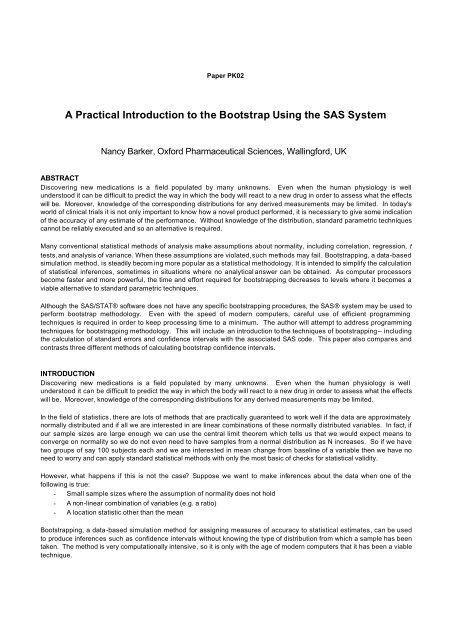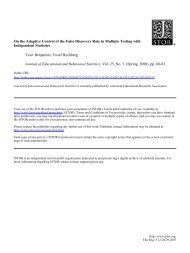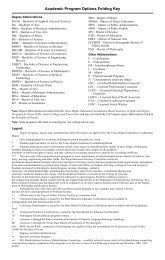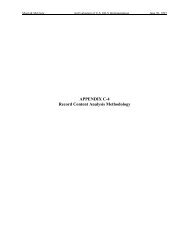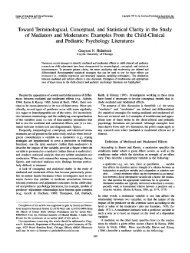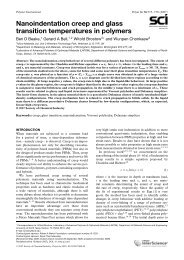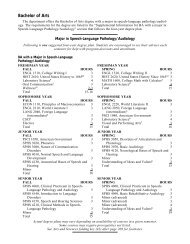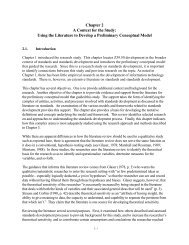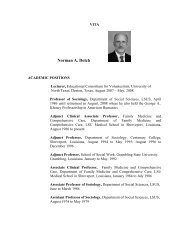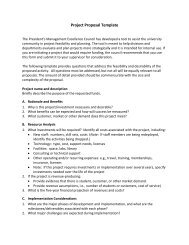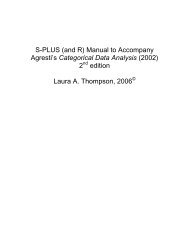A Practical Introduction to the Bootstrap Using the SAS System
A Practical Introduction to the Bootstrap Using the SAS System
A Practical Introduction to the Bootstrap Using the SAS System
Create successful ePaper yourself
Turn your PDF publications into a flip-book with our unique Google optimized e-Paper software.
Paper PK02<br />
A <strong>Practical</strong> <strong>Introduction</strong> <strong>to</strong> <strong>the</strong> <strong>Bootstrap</strong> <strong>Using</strong> <strong>the</strong> <strong>SAS</strong> <strong>System</strong><br />
Nancy Barker, Oxford Pharmaceutical Sciences, Wallingford, UK<br />
ABSTRACT<br />
Discovering new medications is a field populated by many unknowns. Even when <strong>the</strong> human physiology is well<br />
unders<strong>to</strong>od it can be difficult <strong>to</strong> predict <strong>the</strong> way in which <strong>the</strong> body will react <strong>to</strong> a new drug in order <strong>to</strong> assess what <strong>the</strong> effects<br />
will be. Moreover, knowledge of <strong>the</strong> corresponding distributions for any derived measurements may be limited. In <strong>to</strong>day's<br />
world of clinical trials it is not only important <strong>to</strong> know how a novel product performed, it is necessary <strong>to</strong> give some indication<br />
of <strong>the</strong> accuracy of any estimate of <strong>the</strong> performance. Without knowledge of <strong>the</strong> distribution, standard parametric techniques<br />
cannot be reliably executed and so an alternative is required.<br />
Many conventional statistical methods of analysis make assumptions about normality, including correlation, regression, t<br />
tests,and analysis of variance. When <strong>the</strong>se assumptions are violated,such methods may fail. <strong>Bootstrap</strong>ping, a data-based<br />
simulation method, is steadily becom ing more popular as a statistical methodology. It is intended <strong>to</strong> simplify <strong>the</strong> calculation<br />
of statistical inferences, sometimes in situations where no analytical answer can be obtained. As computer processors<br />
become faster and more powerful, <strong>the</strong> time and effort required for bootstrapping decreases <strong>to</strong> levels where it becomes a<br />
viable alternative <strong>to</strong> standard parametric techniques.<br />
Although <strong>the</strong> <strong>SAS</strong>/STAT® software does not have any specific bootstrapping procedures, <strong>the</strong> <strong>SAS</strong>® system may be used <strong>to</strong><br />
perform bootstrap methodology. Even with <strong>the</strong> speed of modern computers, careful use of efficient programming<br />
techniques is required in order <strong>to</strong> keep processing time <strong>to</strong> a minimum. The author will attempt <strong>to</strong> address programming<br />
techniques for bootstrapping methodology. This will include an introduction <strong>to</strong> <strong>the</strong> techniques of bootstrapping – including<br />
<strong>the</strong> calculation of standard errors and confidence intervals with <strong>the</strong> associated <strong>SAS</strong> code. This paper also compares and<br />
contrasts three different methods of calculating bootstrap confidence intervals.<br />
INTRODUCTION<br />
Discovering new medications is a field populated by many unknowns. Even when <strong>the</strong> human physiology is well<br />
unders<strong>to</strong>od it can be difficult <strong>to</strong> predict <strong>the</strong> way in which <strong>the</strong> body will react <strong>to</strong> a new drug in order <strong>to</strong> assess what <strong>the</strong> effects<br />
will be. Moreover, knowledge of <strong>the</strong> corresponding distributions for any derived measurements may be limited.<br />
In <strong>the</strong> field of statistics, <strong>the</strong>re are lots of methods that are practically guaranteed <strong>to</strong> work well if <strong>the</strong> data are approximately<br />
normally distributed and if all we are interested in are linear combinations of <strong>the</strong>se normally distributed variables. In fact, if<br />
our sample sizes are large enough we can use <strong>the</strong> central limit <strong>the</strong>orem which tells us that we would expect means <strong>to</strong><br />
converge on normality so we do not even need <strong>to</strong> have samples from a normal distribution as N increases. So if we have<br />
two groups of say 100 subjects each and we are interested in mean change from baseline of a variable <strong>the</strong>n we have no<br />
need <strong>to</strong> worry and can apply standard statistical methods with only <strong>the</strong> most basic of checks for statistical validity.<br />
However, what happens if this is not <strong>the</strong> case? Suppose we want <strong>to</strong> make inferences about <strong>the</strong> data when one of <strong>the</strong><br />
following is true:<br />
- Small sample sizes where <strong>the</strong> assumption of normality does not hold<br />
- A non-linear combination of variables (e.g. a ratio)<br />
- A location statistic o<strong>the</strong>r than <strong>the</strong> mean<br />
<strong>Bootstrap</strong>ping, a data-based simulation method for assigning measures of accuracy <strong>to</strong> statistical estimates, can be used<br />
<strong>to</strong> produce inferences such as confidence intervals without knowing <strong>the</strong> type of distribution from which a sample has been<br />
taken. The method is very computationally intensive, so it is only with <strong>the</strong> age of modern computers that it has been a viable<br />
technique.
The use of statistics in pharmaceutical research is becoming more and more sophisticated. It is increasingly common for<br />
proposed methodology <strong>to</strong> go beyond standard parametric analyses. In addition, cost data – with its extremely non-normal<br />
distribution is regularly collected. <strong>Bootstrap</strong>ping methodology has become a recognised technique for dealing with <strong>the</strong>se<br />
issues. In a recent CPMP guidance document “Guidance on Clinical Trials in Small Populations” (released for<br />
consultation in March 2005 1 ), it is stated that “…some forms of <strong>Bootstrap</strong> methods make no assumptions about data<br />
distributions and so can be considered a ‘safe’ option when <strong>the</strong>re are <strong>to</strong>o few data <strong>to</strong> test or verify model assumptions …<br />
<strong>the</strong>y prove particularly useful where very limited sample data are available…”.<br />
The aim of this paper is <strong>to</strong> introduce <strong>the</strong> reader <strong>to</strong> <strong>the</strong> process of bootstrapping and <strong>to</strong> look in a little more detail at two of <strong>the</strong><br />
more common applications of bootstrapping: estimating standard error (SE) and estimating confidence intervals (CI) for<br />
statistics of interest. It should be noted that while all of <strong>the</strong> necessary calculations and <strong>SAS</strong> code has been included, a<br />
great deal of <strong>the</strong> statistical <strong>the</strong>ory has been glossed over. Readers interested in understanding fully <strong>the</strong> statistical <strong>the</strong>ory<br />
involved should read Efron and Tibshirani(1993) 2 .<br />
WHAT IS BOOTSTRAPPING?<br />
The method of bootstrapping was first introduced by Efron as a method <strong>to</strong> derive <strong>the</strong> estimate of standard error of an<br />
arbitrary estima<strong>to</strong>r. Finding <strong>the</strong> standard error of an estimate is an important activity for every statistician as it is rarely<br />
enough <strong>to</strong> find a point estimate; we always want <strong>to</strong> know how reasonable is <strong>the</strong> estimate – what is <strong>the</strong> variability of <strong>the</strong><br />
estima<strong>to</strong>r? In fact, sometimes statisticians are really greedy and not only want <strong>to</strong> know <strong>the</strong> point estimate and its standard<br />
error but also things like <strong>the</strong> bias or even <strong>the</strong> complete distribution of <strong>the</strong> estima<strong>to</strong>r. If available <strong>the</strong>se can be used <strong>to</strong> create<br />
confidence intervals or <strong>to</strong> test statistical hypo<strong>the</strong>ses around our estima<strong>to</strong>r.<br />
The use of <strong>the</strong> term 'bootstrap' comes from <strong>the</strong> phrase “To pull oneself up by one's bootstraps ” - generally interpreted as<br />
succeeding in spite of limited resources. This phrase comes from <strong>the</strong> adventures of Baron Muchausen - Raspe (1786) 3 In<br />
one of his many adventures, Baron Munchausen had fallen <strong>to</strong> <strong>the</strong> bot<strong>to</strong>m of a lake and just as he was about <strong>to</strong> succumb <strong>to</strong><br />
his fate he thought <strong>to</strong> pick himself up by his own bootstraps!<br />
The method is extremely powerful and Efron once mentioned that he considered calling it ‘The Shotgun’ since it can “…<br />
blow <strong>the</strong> head of any problem if <strong>the</strong> statistician can stand <strong>the</strong> resulting mess”. The quotation relates <strong>to</strong> <strong>the</strong> bootstrap’s wide<br />
applicability in combination with <strong>the</strong> large amount of data that results from its application <strong>to</strong>ge<strong>the</strong>r with <strong>the</strong> large volume of<br />
numerical computation that is required.<br />
Original sample<br />
196, -12, 280, 212, 52, 100, -206, 188, -100, 202<br />
Mean = 91.2<br />
Sample 1 Sample 2 Sample 3 Sample B<br />
100<br />
100<br />
188<br />
280<br />
-100<br />
-100<br />
188<br />
52<br />
188<br />
196<br />
188<br />
202<br />
100<br />
100<br />
212<br />
52<br />
212<br />
-12<br />
-12<br />
202<br />
Figure 1 : Illustration of <strong>the</strong> <strong>Bootstrap</strong> M ethod<br />
202<br />
202<br />
-206<br />
100<br />
-206<br />
188<br />
280<br />
-206<br />
280<br />
280<br />
…<br />
…<br />
-100<br />
-206<br />
52<br />
202<br />
280<br />
196<br />
-206<br />
-12<br />
188<br />
-100<br />
Mean=109.2 Mean=124.4 Mean=91.4 Mean=29.4
The bas ic idea behind a bootstrap is that for some reason we do not know how <strong>to</strong> calculate <strong>the</strong> <strong>the</strong>oretically appropriate<br />
significance test for a statistic: Some possible examples are that we want <strong>to</strong> do a t-test on a mean when <strong>the</strong> data is nonnormal<br />
or perhaps we want <strong>to</strong> do a t-test on a median or maybe we want do a regression where <strong>the</strong> assumptions about <strong>the</strong><br />
error term are violated.<br />
<strong>Using</strong> <strong>the</strong> bootstrap approach assumes that <strong>the</strong> data are a random sample. The bootstrap simulates what would happen if<br />
repeated samples of <strong>the</strong> population could be taken by taking repeated samples of <strong>the</strong> data available. These repeated<br />
samples could each be smaller than <strong>the</strong> data available and could be done with or without replacement. Empirical research<br />
suggests that <strong>the</strong> best results are obtained with <strong>the</strong> repeated samples are <strong>the</strong> same size as <strong>the</strong> original sample and when<br />
it is done with replacement. Figure 1 illustrates this process.<br />
Suppose we take a simple example, where we wish <strong>to</strong> estimate <strong>the</strong> standard error for a mean. We have 10 observations<br />
showing change from baseline for some variable X.<br />
The original data set is randomly sampled with replacement B times with each sample containing exactly 10 observations<br />
(four of <strong>the</strong>se samples are shown in Figure 1). Note that using random selection with replacement means that an<br />
individual value from <strong>the</strong> original data set can be included repeatedly within a bootstrap sample while o<strong>the</strong>r values may not<br />
be included at all. This is bootstrap replication.<br />
The re-estimated statistics fall in a certain distribution; this may be viewed as a his<strong>to</strong>gram (see Figure 2 below). This<br />
his<strong>to</strong>gram show us an approximate estimate of <strong>the</strong> sampling distribution of <strong>the</strong> original statistic (in our case of <strong>the</strong> mean),<br />
and any function of that sampling distribution may be estimated by calculating <strong>the</strong> function on <strong>the</strong> basis of <strong>the</strong> his<strong>to</strong>gram.<br />
Figure 2: His<strong>to</strong>gram showing <strong>the</strong> estimated distribution of <strong>the</strong> mean for <strong>the</strong> sample data, based on 1000 replications<br />
For example, <strong>the</strong> standard deviation (SD) of <strong>the</strong> re-estimated means is a reliable estimate of <strong>the</strong> standard error of <strong>the</strong> mean<br />
(that is, <strong>the</strong> average amount of scatter inherent in <strong>the</strong> statistic, or <strong>the</strong> average distance away from <strong>the</strong> mean at which o<strong>the</strong>r<br />
similarly constructed means would occur). So <strong>to</strong> find <strong>the</strong> standard error of <strong>the</strong> mean, we calculate <strong>the</strong> mean for each of <strong>the</strong><br />
B bootstrap samples and <strong>the</strong> find <strong>the</strong> standard deviation of <strong>the</strong>se means.<br />
The more bootstrap replications we use, <strong>the</strong> more ‘replicable’ <strong>the</strong> result will be when a different set of samples is used. So<br />
if we re-ran <strong>the</strong> bootstrap analysis, we would be more likely <strong>to</strong> see <strong>the</strong> same results if we use a high number of bootstrap<br />
samples. To illustrate this, Table 1 shows <strong>the</strong> results of <strong>the</strong> bootstrap analyses, run 5 times each on B=20, 50, 100 and<br />
1000.<br />
From Table 1 below, we can see that <strong>the</strong> more replications we use <strong>the</strong> more likely we are <strong>to</strong> get similar results <strong>to</strong> previous<br />
analyses (i.e. reliability). In general I would recommend using at least 100 replications for reliability when calculating<br />
standard error.
Table 1: Results of bootstrap analyses with 20, 50, 100 and 1000 bootstrap replications<br />
Number of<br />
Estimate of<br />
<strong>Bootstrap</strong><br />
Standard Error<br />
Replications (B)<br />
Original sample 49.44<br />
20 49.69<br />
20 30.82<br />
20 52.93<br />
20 59.13<br />
20 32.52<br />
50 45.64<br />
50 47.52<br />
50 49.64<br />
50 39.93<br />
50 51.51<br />
100 49.20<br />
100 56.05<br />
100 52.04<br />
100 44.53<br />
100 45.08<br />
1000 47.39<br />
1000 50.03<br />
1000 48.03<br />
1000 49.13<br />
1000 48.47<br />
Note that if we were interested in <strong>the</strong> median instead of <strong>the</strong> mean, we could easily create a standard error for <strong>the</strong> median<br />
but performing exactly <strong>the</strong> same process, but taking <strong>the</strong> standard deviation of <strong>the</strong> sample medians instead of <strong>the</strong> sample<br />
means. This is not something that could be done with standard parametric methodology.<br />
BOOTSTRAPPING WITH THE <strong>SAS</strong> SYSTEM<br />
<strong>Bootstrap</strong>ping using <strong>SAS</strong> is relatively simple. The POINT= option in a SET command of a DATA STEP allows us <strong>to</strong> easily<br />
pick out <strong>the</strong> observations we require.<br />
If <strong>the</strong> original data is contained within <strong>the</strong> data set ORIGINAL and we can combine <strong>the</strong> RANUNI function with <strong>the</strong> POINT<br />
option <strong>to</strong> select our values as follows:<br />
data bootsamp;<br />
do i = 1 <strong>to</strong> nobs; /* Want same no. obs as in ORIGINAL */<br />
x = round(ranuni(0) * nobs); /* x randomly selected from values 1 <strong>to</strong> NOBS */<br />
set original<br />
nobs = nobs<br />
point = x; /* This selected <strong>the</strong> xth observation in ORIGINAL */<br />
output; /* Send <strong>the</strong> selected observation <strong>to</strong> <strong>the</strong> new data set */<br />
end;<br />
s<strong>to</strong>p; /* Required when using <strong>the</strong> POINT= command */<br />
run;<br />
The resultant data set BOOTSAMP contains a single bootstrap replication with all variables from <strong>the</strong> original data set and
with <strong>the</strong> same number of records. We can <strong>the</strong>n go on <strong>to</strong> perform <strong>the</strong> analysis required. Note that it is important <strong>to</strong> use a<br />
different seed each time you create a sample in <strong>the</strong> RANUNI( ) function or you will create <strong>the</strong> same sample each time.<br />
EFFICIENT PROGRAMMING<br />
When performing bootstrapping operations it is extremely important <strong>to</strong> use efficient programming techniques. If we were <strong>to</strong><br />
create each bootstrap sample individually, <strong>the</strong>n perform <strong>the</strong> analysis required (PROC MEANS in <strong>the</strong> case of <strong>the</strong> example<br />
above), and append <strong>the</strong> results <strong>to</strong> <strong>the</strong> previous samples we require a lot longer for our programming.<br />
Whenever possible, it is much better <strong>to</strong> use BY processing. If we were <strong>to</strong> create all our bootstrap samples simultaneously<br />
and <strong>the</strong>n used PROC MEANS with a BY or CLASS statement, <strong>the</strong> difference in times can be quite startling. Creating <strong>the</strong><br />
bootstrap samples simultaneously is simply a matter of using an additional DO statement in <strong>the</strong> DATA STEP as follows:<br />
data bootsamp;<br />
do sampnum = 1 <strong>to</strong> 1000; /* To create 1000 bootstrap replications */<br />
do i = 1 <strong>to</strong> nobs;<br />
x = round(ranuni(0) * nobs);<br />
set original<br />
nobs = nobs<br />
point = x;<br />
output;<br />
end;<br />
end;<br />
s<strong>to</strong>p;<br />
run;<br />
This will create a data set with 1000*no. observations in ORIGINAL. Each bootstrap sample will be identified using <strong>the</strong><br />
variable SAMPNUM which can be used <strong>to</strong> perform later BY processing.<br />
<strong>Using</strong> <strong>the</strong> first method of creating each sample and finding its mean individually and appending <strong>the</strong> result <strong>to</strong> <strong>the</strong> data set<br />
containing <strong>the</strong> means from <strong>the</strong> previously calculated samples <strong>to</strong>ok <strong>the</strong> author’s home computer a <strong>to</strong>tal of 2 minutes and 41<br />
seconds. <strong>Using</strong> <strong>the</strong> second method of creating all samples simultaneously <strong>the</strong>n using PROC MEANS with a CLASS<br />
statement <strong>to</strong>ok approximately 1 second.<br />
From this we can see that <strong>the</strong> optimal method of running code is <strong>to</strong> create all samples within a single data set and <strong>the</strong>n<br />
use by processing (with <strong>the</strong> sample number as <strong>the</strong> BY variable). However, this is not always possible. You may be running<br />
an analysis that requires some form of coding that has no BY processing (e.g. <strong>SAS</strong>/IML) it may be that your initial data set is<br />
so large that your computer could not deal with running everything at once. In such a case <strong>the</strong> author would recommend<br />
closing your log before running (ODS LOG CLOSE;) as this gives a slight time saving. Running <strong>the</strong> code in this manner<br />
reduced <strong>the</strong> time from 2 minutes and 41 seconds <strong>to</strong> 1 minute and 50 seconds.<br />
BOOTSTRAPPING FOR TREATMENT GROUP COMPARISONS<br />
In <strong>the</strong> majority of clinical work, we are looking <strong>to</strong> compare two or more treatments. To do this we often use randomisation <strong>to</strong><br />
assign <strong>the</strong> subjects <strong>to</strong> each treatment.<br />
Suppose we have a trial with two treatment groups. If we were <strong>to</strong> use <strong>the</strong> bootstrapping methods <strong>to</strong> randomly select<br />
subjects we would have many bootstrap samples where <strong>the</strong> balance of subjects in each treatment group is different from<br />
<strong>the</strong> original sample. Instead, we need <strong>to</strong> create bootstrap samples which have <strong>the</strong> same number of observations in each<br />
group as are found in <strong>the</strong> original. To do this we re-sample independently for each treatment group and <strong>the</strong>n reset <strong>the</strong><br />
observations <strong>to</strong>ge<strong>the</strong>r.<br />
Consider our original example: let us suppose that we had ano<strong>the</strong>r 10 subjects in <strong>the</strong> study who were on a different<br />
treatment. Suppose that <strong>the</strong> first set of data came from subjects treated with ‘active’ (referred <strong>to</strong> as Active) medication while<br />
a fur<strong>the</strong>r 10 subjects came from a group on ‘placebo’ (referred <strong>to</strong> as Placebo) medication (with values = 120, -80, -63, 200,<br />
23, 54, -198, 165, -8, 19). This time, we wish <strong>to</strong> find <strong>the</strong> difference between <strong>the</strong> means of <strong>the</strong> two groups.<br />
As discussed above, we create bootstrap samples which each have 10 Active values and 10 Placebo values, by<br />
independently sampling from each group. We <strong>the</strong>n calculate <strong>the</strong> mean for each group within each sample and find <strong>the</strong>
difference between <strong>the</strong> means (our statistic of interest) for each sample. We can <strong>the</strong>n look at <strong>the</strong> distribution of this statistic<br />
in exactly <strong>the</strong> same way as we did for <strong>the</strong> ‘single group’ mean above.<br />
To do this with <strong>SAS</strong> we need <strong>to</strong> split <strong>the</strong> data before re-sampling. Unfortunately, <strong>the</strong> POINT= option does not work when <strong>the</strong><br />
WHERE= option is also used in <strong>the</strong> set statement, so two DATA steps are required: <strong>the</strong> first <strong>to</strong> divide <strong>the</strong> datasets for each<br />
treatment group and <strong>the</strong> second <strong>to</strong> perform <strong>the</strong> bootstrap sampling. If <strong>the</strong> original data set (ORIGINAL) contains two<br />
variables called CHANGE (for change from Baseline value) and TRT (treatment: 1=Active, 2=Placebo) – <strong>the</strong> following code<br />
will perform <strong>the</strong> desired analysis.<br />
%macro bootse(b);<br />
data orig1 (where=(trt=1))<br />
orig2 (where=(trt=2)); /* Create one data set for each treatment */<br />
set original;<br />
run;<br />
data boot;<br />
%do t=1 %<strong>to</strong> 2; /* Create independent sets of replications */<br />
do sample=1 <strong>to</strong> &b;<br />
do i = 1 <strong>to</strong> nobs;<br />
pt = round(ranuni(&t)*nobs) ;<br />
set orig&t nobs = nobs point=pt; /*use treatment-specific data */<br />
output;<br />
end;<br />
end;<br />
%end;<br />
s<strong>to</strong>p;<br />
run;<br />
proc means /* find <strong>the</strong> mean, by sample and treatment */<br />
data=boot<br />
noprint<br />
nway;<br />
class sample trt;<br />
var change;<br />
output out=x<br />
mean=mean;<br />
run;<br />
data diffmean;<br />
merge x (where=(trt=1) rename=(mean=mean1))<br />
x (where=(trt=2) rename=(mean=mean2));<br />
by sample;<br />
diffmean=mean1-mean2; /* calculate <strong>the</strong> difference between <strong>the</strong> means */<br />
run;<br />
proc means<br />
data=diffmean<br />
std;<br />
var diffmean;<br />
output out=bootse<br />
std=bootse;<br />
run;<br />
%mend;
CALCULATING CONFIDENCE INTERVALS USING THE BOOTSTRAP<br />
So far we have looked at <strong>the</strong> computation of bootstrap standard errors. Standard errors are often used <strong>to</strong> assign<br />
approximate confidence intervals <strong>to</strong> a parameter θ . For example, given an estimate θˆ and an estimated standard error<br />
sˆ e , <strong>the</strong> usual 95% confidence interval is:<br />
Mean ± 1.96*SE. = θ ˆ ±1.96 * sˆ e<br />
This is based on <strong>the</strong> assumption that:<br />
Z =<br />
θˆ<br />
−<br />
s e<br />
)θ<br />
∼N(0, 1) (i.e. is approximately distributed <strong>to</strong> <strong>the</strong> Normal distribution with mean=0 and sd=1)<br />
This is valid as n→ ∞, but is only an approximation for finite samples. A better approximation would perhaps use <strong>the</strong> t<br />
distribution and assume that (for a sample size of n):<br />
Z =<br />
θˆ<br />
−<br />
s e<br />
)θ<br />
∼ t<br />
n−1<br />
(i.e. is approximately distributed <strong>to</strong> <strong>the</strong> t-distribution with n-1 degrees of freedom)<br />
For small samples this is a better approximation, but <strong>the</strong> use of <strong>the</strong> t distribution doesn’t adjust <strong>the</strong> confidence interval <strong>to</strong><br />
account for <strong>the</strong> skewness in <strong>the</strong> underlying population – or o<strong>the</strong>r errors that can result when θˆ is not <strong>the</strong> sample mean.<br />
Through <strong>the</strong> use of bootstrapping we can obtain accurate intervals without having <strong>to</strong> make normal <strong>the</strong>ory assumptions.<br />
There are a variety of methods available which compute confidence intervals and we will go in<strong>to</strong> a little detail on each.<br />
In general, <strong>the</strong> variability between estima<strong>to</strong>rs for confidence intervals is greater than for standard errors and so it is better <strong>to</strong><br />
have a larger number of bootstrap replications. The 100 replications recommended <strong>to</strong> calculate standard errors is not<br />
really acceptable for confidence limits. This author would generally recommend a set of 10,000 replications. The sampling<br />
error and number of replications required will not be discussed here. Efron and Tibshirani 1 (Chapter 19) gives an excellent<br />
discussion of this for those wishing for more detail.<br />
For each of <strong>the</strong> following types of confidence intervals, we will demonstrate <strong>the</strong> <strong>SAS</strong> code required, assuming that we are<br />
trying <strong>to</strong> calculate a 95% confidence interval for <strong>the</strong> difference between <strong>the</strong> means for <strong>the</strong> example data above. In all cases,<br />
<strong>the</strong> %BOOTSE macro will be run and will create <strong>the</strong> data sets BOOT, DIFFMEANS and BOOTSE are in <strong>the</strong> section above.<br />
THE BOOTSTRAP-T INTERVAL<br />
This method allows us <strong>to</strong> estimate <strong>the</strong> distribution of our statistic Z =<br />
θˆ<br />
−<br />
s e<br />
)θ<br />
directly from <strong>the</strong> data.<br />
Suppose we create a set of bootstrap samples. For each, we estimate a value of Z as follows:<br />
where ˆ *( b)<br />
and ( )<br />
Ζ *<br />
( b)<br />
θ is <strong>the</strong> estimate of θˆ for <strong>the</strong> b th bootstrap sample<br />
s eˆ * b is <strong>the</strong> estimated standard error of ˆ *<br />
The α th percentile of ( )<br />
Ζ * b is estimated as <strong>the</strong> value<br />
( b)<br />
( b)<br />
θˆ*<br />
−θˆ<br />
=<br />
seˆ*<br />
θ for <strong>the</strong> b th bootstrap sample.<br />
( α )<br />
tˆ such that:<br />
#<br />
{ ( )<br />
Ζ*<br />
( b) ≤ tˆ<br />
} α<br />
= α<br />
Β<br />
where #{x} denotes <strong>the</strong> number of observations which meet condition x<br />
The confidence interval is <strong>the</strong>n calculated as:<br />
( ) ( )<br />
( ˆ 1<br />
θ − tˆ<br />
× seˆ,<br />
ˆ − tˆ<br />
× seˆ<br />
)<br />
−α<br />
θ<br />
α
This looks like really complicated statistics, but in practice is not difficult.<br />
For example, if we want <strong>to</strong> calculate a 95% confidence interval for <strong>the</strong> mean and we plan <strong>to</strong> use 10,000 bootstrap samples,<br />
Ζ * b as (mean<br />
we estimate <strong>the</strong> value of <strong>the</strong> mean and its standard error for each sample. Then we calculate <strong>the</strong> value ( )<br />
of bootstrapped sample – mean of original sample)/SE of bootstrapped sample.<br />
We <strong>the</strong>n order <strong>the</strong> values of ( )<br />
Ζ * b from low <strong>to</strong> high and take<br />
( 0.025)<br />
ˆt = 250 th value and<br />
( 0.975)<br />
ˆt =9750 th value.<br />
The confidence interval is <strong>the</strong>n calculated using <strong>the</strong> mean from <strong>the</strong> original sample (θˆ) and <strong>the</strong> estimated standard error<br />
( sˆ e as calculated in <strong>the</strong> previous section).<br />
So <strong>the</strong> lower limit =θˆ -(<br />
( 0.975)<br />
ˆt x e<br />
To do this in <strong>SAS</strong> we would use <strong>the</strong> following code:<br />
%bootse(10000);<br />
s ˆ<br />
( 0.025)<br />
) and <strong>the</strong> upper limit is θˆ -( ˆt x seˆ ).<br />
data boo<strong>to</strong>rig; /* set original and sample data <strong>to</strong>ge<strong>the</strong>r so can */<br />
set original (in=a) /* calculate mean values in one procedure */<br />
boot;<br />
if a <strong>the</strong>n sample=0;<br />
run;<br />
proc means<br />
data=boo<strong>to</strong>rig<br />
noprint<br />
nway;<br />
class sample trt;<br />
var change;<br />
output out=x /* mean and standard error for each sample */<br />
mean=mean<br />
var=var<br />
n=n;<br />
run;<br />
data diff_z;<br />
merge x (where=(trt=1) rename=(mean=mean1 var=var1 n=n1))<br />
x (where=(trt=2) rename=(mean=mean2 var=var2 n=n2));<br />
by sample;<br />
diffmean=mean1-mean2; /* calculate <strong>the</strong> difference between <strong>the</strong> means */<br />
diffse = sqrt((var1+var2)/(n1+n2)); /* estimate SE of difference */<br />
retain origdiff; /* add value of original estimate */<br />
if sample=0 <strong>the</strong>n origdiff=diffmean; /* of difference <strong>to</strong> each record */<br />
diff_z = (diffmean - origdiff)/diffse;<br />
run;<br />
proc sort<br />
data=diff_z; /* order diff_z from low <strong>to</strong> high */<br />
by diff_z;<br />
run;
data t_vals; /* data set containing values for t(0.975) and t(0.025) */<br />
set diff_z end=eof;<br />
retain t_lo t_hi;<br />
if _n_=9750 <strong>the</strong>n t_lo=diff_z;<br />
if _n_= 250 <strong>the</strong>n t_hi=diff_z;<br />
if eof <strong>the</strong>n output;<br />
run;<br />
data ci_t;<br />
merge diff_z (where=(sample=0))<br />
bootse (keep=bootse)<br />
t_vals (keep=t_:);<br />
conf_lo = origdiff - (t_lo * bootse);<br />
conf_hi = origdiff - (t_hi * bootse);<br />
keep origdiff bootse t_lo t_hi conf_lo conf_hi;<br />
run;<br />
A print out of <strong>the</strong> final data set ci_t would give us <strong>the</strong> following:<br />
origdiff bootse t_lo t_hi conf_lo conf_hi<br />
103.2 60.2505 3.44251 -3.08735 -104.213 289.215<br />
Giving us a confidence limit of (-104.2, 289.2) for <strong>the</strong> difference in <strong>the</strong> means between <strong>the</strong> groups.<br />
It should be noted that in order <strong>to</strong> calculate our Ζ *( b)<br />
statistic for each bootstrap sample, we require <strong>the</strong> s eˆ<br />
* ( b)<br />
standard error of θ ˆ* ( b)<br />
for <strong>the</strong> b th sample. For this example, we were able <strong>to</strong> use <strong>the</strong> plug-in estimate:<br />
SE for difference between means =<br />
VAR(<br />
A)<br />
+ VAR(<br />
B)<br />
n A<br />
+ n B<br />
, <strong>the</strong><br />
However, what happens if we want <strong>to</strong> look at a statistic for which <strong>the</strong>re is no parametric approximation of <strong>the</strong> standard<br />
error? In order <strong>to</strong> approximate <strong>the</strong> standard error, we would need <strong>to</strong> calculate a bootstrap estimate for each bootstrap<br />
sample. In o<strong>the</strong>r words, two nested levels of bootstrapping. Since we are recommending a minimum of 100 replications in<br />
order <strong>to</strong> estimate a standard error and at least 1000 replications in order <strong>to</strong> calculate confidence intervals, this would give<br />
an overall number of bootstrap replications of 100*10000=1,000,000 – a formidable number, especially if our statistic of<br />
interest is costly <strong>to</strong> compute!<br />
THE PERCENTILE INTERVAL<br />
This is <strong>the</strong> simplest of <strong>the</strong> methods for calculating a bootstrap confidence interval. If we wish <strong>to</strong> calculate a 95% confidence<br />
interval we simply select <strong>the</strong> bootstrap estimates which lie on <strong>the</strong> 2.5 th percentile and 97.5 th percentile. So if we had<br />
calculated 10000 bootstrap estimates of our statisticθ . We would order <strong>the</strong>m from low <strong>to</strong> high and take <strong>the</strong> 250 th value as<br />
<strong>the</strong> lower limit and <strong>the</strong> 9750 th value as <strong>the</strong> upper limit.<br />
Within <strong>SAS</strong> this is very straightforward:<br />
%bootse(10000);<br />
proc sort<br />
data=diffmean; /* sort estimates for difference from low <strong>to</strong> high */<br />
by diffmean;<br />
run;
data ci_perc;<br />
set diffmean end=eof; /* pull out 250th and 9750th values as confidence limits */<br />
retain conf_lo conf_hi;<br />
if _n_= 250 <strong>the</strong>n conf_lo=diffmean;<br />
if _n_=9750 <strong>the</strong>n conf_hi=diffmean;<br />
if eof <strong>the</strong>n output;<br />
keep conf_lo conf_hi;<br />
run;<br />
A print out of <strong>the</strong> final data set ci_t would give us <strong>the</strong> following:<br />
conf_lo conf_hi<br />
-26 208.7<br />
Giving us a confidence limit of (-26.0, 208.7) for <strong>the</strong> difference in <strong>the</strong> means between <strong>the</strong> groups.<br />
BETTER CONFIDENCE INTERVALS<br />
One of <strong>the</strong> most important goals of bootstrap methodology is that we produce confidence intervals which closely match<br />
‘exact’ confidence intervals in <strong>the</strong> situations where statistical <strong>the</strong>ory yields an exact answer. Unfortunately, nei<strong>the</strong>r <strong>the</strong><br />
bootstrap-t method, nor <strong>the</strong> percentile method defined above meet this goal. The bootstrap-t intervals have good <strong>the</strong>oretical<br />
coverage – but tend <strong>to</strong> be erratic in practice. In addition, if no statistical formulae are available <strong>to</strong> estimate <strong>the</strong> standard<br />
error for <strong>the</strong> statistic of interest, a nested bootstrap procedure is required which can increase <strong>the</strong> required number of<br />
samples (and hence required computational time) exponentially. The percentile intervals are simpler <strong>to</strong> use and less<br />
erratic but comparison with exact statistical methods have demonstrated <strong>the</strong>se <strong>to</strong> have less than satisfac<strong>to</strong>ry coverage in<br />
some cases.<br />
Part of <strong>the</strong> problem with <strong>the</strong>se confidence intervals is that <strong>the</strong>y are unable <strong>to</strong> deal with <strong>the</strong> issues related <strong>to</strong>:<br />
1. <strong>the</strong> bootstrap estimates are biased with respect <strong>to</strong> <strong>the</strong> original estimate<br />
2. <strong>the</strong> standard error varies with <strong>the</strong> value of <strong>the</strong> estimate<br />
An improved version of <strong>the</strong> percentile method has been formulated <strong>to</strong> help deal with <strong>the</strong>se problems. The bias -corrected<br />
and accelerated (BCa) intervals have been shown <strong>to</strong> have a substantial improvement over <strong>the</strong> percentile method in both<br />
<strong>the</strong>ory and practice. The method does however require a little knowledge of bias and jackknifing techniques before <strong>the</strong><br />
computation can be performed.<br />
BIAS<br />
In statistics, bias is defined as “any systematic failure of a sample <strong>to</strong> represent its population base”. In <strong>the</strong> case of<br />
bootstrapping, we want <strong>to</strong> see if <strong>the</strong>re is a median bias – i.e. a systematic underestimation or overestimation of our sample<br />
statistic when calculated by <strong>the</strong> bootstrap replications. To do this we look at <strong>the</strong> proportion of samples which calculate a<br />
sample statistic which is below <strong>the</strong> statistic calculated by <strong>the</strong> original sample.<br />
Let<br />
θˆ<br />
( b)<br />
= <strong>the</strong> actual statistic calculated on <strong>the</strong> original records<br />
ˆ*<br />
θ<br />
= <strong>the</strong> statistic calculated from <strong>the</strong> b th bootstrap sample<br />
B<br />
Then <strong>the</strong> bias correction<br />
0<br />
= <strong>the</strong> number of bootstrap samples<br />
{ θˆ<br />
}<br />
⎜<br />
θˆ<br />
*( )<br />
Φ − 1 # b<br />
ẑ B<br />
=<br />
⎛ <<br />
⎝<br />
where<br />
{ } condition #<br />
= number of samples <strong>to</strong> meet <strong>the</strong> specified condition<br />
⎞<br />
⎟<br />
⎠
−1<br />
Φ ( x)<br />
−1<br />
and indicates <strong>the</strong> inverse function of a standard normal distribution (PROBIT function in <strong>SAS</strong>) e.g. ( 0.975)<br />
1.96.<br />
To calculate this in <strong>SAS</strong> for our example for difference between <strong>the</strong> means we would use <strong>the</strong> following code:<br />
%bootse(10000);<br />
data boo<strong>to</strong>rig; /* set original and sample data <strong>to</strong>ge<strong>the</strong>r so can calculate */<br />
set original (in=a) /* mean values in one procedure */<br />
boot;<br />
if a <strong>the</strong>n sample=0;<br />
run;<br />
proc means<br />
data=boo<strong>to</strong>rig<br />
noprint<br />
nway;<br />
class sample trt;<br />
var change;<br />
output out=bootmean /* mean for each sample */<br />
mean=mean;<br />
run;<br />
data diffmean (keep=sample diffmean) /* data set containing bootstrap values */<br />
bias (keep=bias); /* data set containing bias correction value */<br />
merge bootmean (where=(trt=1) rename=(mean=mean1))<br />
bootmean (where=(trt=2) rename=(mean=mean2)) end=eof;<br />
by sample;<br />
diffmean=mean1-mean2; /* calculate <strong>the</strong> difference between <strong>the</strong> means */<br />
retain origdiff; /* add value of original estimate */<br />
if sample=0 <strong>the</strong>n origdiff=diffmean; /* difference <strong>to</strong> each record */<br />
if diffmean lt origdiff <strong>the</strong>n lessthan=1; /*flag if bootstrap sample gives lower */<br />
else lessthan=0; /*value than original sample */<br />
retain nless 0;<br />
if sample gt 0 <strong>the</strong>n nless=nless+lessthan; /* count samples with flag lessthan */<br />
if sample ne 0 <strong>the</strong>n output diffmean; /* output only bootstrap sample statistics */<br />
if eof <strong>the</strong>n do; /* for <strong>the</strong> last value calculate: */<br />
propless=nless/sample; /* 1. proportion of values below original estimate */<br />
bias=probit(propless); /* 2. inverse normal of that proportion */<br />
output bias; /* 3. output only that record <strong>to</strong> new data set */<br />
end;<br />
run;<br />
Φ =<br />
For our data, 54.5% of bootstrap samples gave differences between <strong>the</strong> means which were less than that found by <strong>the</strong><br />
original sample. This gives us a value for <strong>the</strong> bias of 0.1135.<br />
JACKKNIFING AND ACCELERATION<br />
The acceleration statistic refers <strong>to</strong> <strong>the</strong> rate of change of <strong>the</strong> standard error of <strong>the</strong> estimate of our sample statistic with respect
<strong>to</strong> <strong>the</strong> true value of <strong>the</strong> statistic. Efron and Tibshirani proposed that this be calculated using jackknife values of <strong>the</strong> estimate<br />
of <strong>the</strong> statistic.<br />
Jackknifing looks at how much each individual record influences <strong>the</strong> estimate. To do this we recalculate <strong>the</strong> estimate of <strong>the</strong><br />
LED with all but one record - removing each record in turn. For our example we would create a set of (10+10)=20 estimates for<br />
<strong>the</strong> difference between <strong>the</strong> mean which are each based on 19 of <strong>the</strong> records with a different record being removed each time.<br />
Let<br />
θˆ<br />
n<br />
( i)<br />
= <strong>the</strong> statistic of interest calculated on <strong>the</strong> jackknifed sample with <strong>the</strong> i th record removed<br />
= <strong>the</strong> number of jackknifed samples i.e. <strong>the</strong> number of records across all treatment groups<br />
θˆ (•)<br />
= <strong>the</strong> mean of <strong>the</strong> n jackknife samples = ∑ n<br />
i = 1<br />
Then <strong>the</strong> acceleration â =<br />
⎧<br />
6⎨<br />
⎩<br />
∑<br />
i=<br />
1<br />
n<br />
n<br />
∑<br />
i=<br />
1<br />
( θˆ<br />
−θˆ<br />
)<br />
(•) ( i)<br />
( θˆ<br />
−θˆ<br />
)<br />
(•) ( i)<br />
2<br />
3<br />
⎫<br />
⎬<br />
⎭<br />
3<br />
2<br />
This statistic may look a little daunting, but is easy <strong>to</strong> calculate. We simply create our jackknife samples, find <strong>the</strong> difference<br />
between <strong>the</strong> mean of <strong>the</strong> samples and each sample and calculate both a squared value and a cubed value of our<br />
difference. Then we sum <strong>the</strong>se squared and cubed differences and plug <strong>the</strong> values in<strong>to</strong> <strong>the</strong> equation. In <strong>SAS</strong>, for our<br />
example, we would use <strong>the</strong> following code.<br />
data origjack; /* create a new data set which contains observation */<br />
set original end=eof; /* numbers 1 <strong>to</strong> &nobs (no. obs in data set) */<br />
obsnum=_n_;<br />
if eof <strong>the</strong>n call symput('nobs', put(obsnum, 2.));<br />
run;<br />
%macro jackdata; /* use macro for %do processing utility */<br />
data jackdata;<br />
set<br />
%do i=1 %<strong>to</strong> &nobs; /* do loop <strong>to</strong> create all samples */<br />
origjack (in = in&i<br />
where=(obsnum ne &i)) /* remove a different value each time */<br />
%end;;<br />
%do i=1 %<strong>to</strong> &nobs;<br />
if in&i <strong>the</strong>n repeat=&i; /* add repeat number for each sample */<br />
%end;<br />
run;<br />
%mend;<br />
%jackdata;<br />
proc means<br />
data=jackdata<br />
noprint<br />
nway;<br />
class repeat trt;<br />
var change;<br />
output out=jacksum /* mean for each sample */<br />
mean=mean;<br />
run;<br />
θ ˆ n
data jacksum2;<br />
merge jacksum1 (where=(trt=1) rename=(mean=mean1))<br />
jacksum1 (where=(trt=2) rename=(mean=mean2));<br />
by repeat;<br />
diffmean=mean1-mean2; /* calculate <strong>the</strong> difference between <strong>the</strong> means */<br />
run;<br />
proc sql<br />
noprint;<br />
select mean(diffmean) /* put mean of jackknifed values in<strong>to</strong> macro variable */<br />
in<strong>to</strong> :meanjack<br />
from jacksum2;<br />
quit;<br />
data jacksum3;<br />
set jacksum2;<br />
cubed=(&meanjack - diffmean)**3; /* create cubed value of difference */<br />
squared=(&meanjack - diffmean)**2; /* create squared value of difference */<br />
run;<br />
proc means<br />
data=jacksum3<br />
noprint;<br />
output out=jacksum4<br />
sum(cubed)=sumcube /* find sum of cubed values */<br />
sum(squared)=sumsquar; /* find sum of squared values */<br />
run;<br />
data accel;<br />
set jacksum4;<br />
accel=sumcube / (6 * (sumsquar**1.5)); /* plug values in<strong>to</strong> equation for */<br />
keep accel; /* <strong>the</strong> acceleration statistic */<br />
run;<br />
For our data, <strong>the</strong> acceleration statistic calculated is -0.0238.<br />
CALCULATING THE BCA INTERVAL<br />
ẑ and acceleration statistic â , we need <strong>to</strong> use <strong>the</strong>se <strong>to</strong> select which of our B<br />
Once we have calculated <strong>the</strong> bias correction<br />
0<br />
(B=10,000 in our examples) bootstrapped values <strong>to</strong> take as <strong>the</strong> end points in our 100*(1-2α) (α=0.025 for a 95% CI)<br />
confidence interval.<br />
This is done in four simple steps:<br />
1. Calculate α 1 =<br />
and α 2 =<br />
⎛<br />
Φ⎜<br />
z<br />
⎝<br />
Where ( x)<br />
−1<br />
and as before, ( x)<br />
⎛<br />
Φ⎜<br />
z ˆ<br />
⎝<br />
0<br />
zˆ<br />
0<br />
+ Φ<br />
+<br />
1−<br />
aˆ<br />
zˆ<br />
0<br />
+ Φ<br />
+<br />
1−<br />
aˆ<br />
−1<br />
ˆ0<br />
1<br />
−1<br />
( α )<br />
−1<br />
( α )<br />
⎞<br />
( zˆ<br />
+ Φ ) ⎟⎟ 0 ⎠<br />
( 1−<br />
α )<br />
−<br />
( 1−<br />
α )<br />
⎞<br />
( zˆ<br />
+ Φ ) ⎟⎟ 0<br />
⎠<br />
Φ is <strong>the</strong> standard normal cumulative distribution function (PROBNORM function in <strong>SAS</strong>).<br />
Φ indicates <strong>the</strong> inverse function of a standard normal distribution (PROBIT function).<br />
2. Calculate<br />
N =<br />
1<br />
Β ×α 1<br />
rounded down <strong>to</strong> <strong>the</strong> nearest integer
and N 2 = Β ×α2<br />
rounded up <strong>to</strong> <strong>the</strong> nearest integer<br />
3. Order <strong>the</strong> calculated statistic (difference between <strong>the</strong> means in our example) calculated from <strong>the</strong> B bootstrapped<br />
samples (as already created <strong>to</strong> calculate <strong>the</strong> bias-correction estimate) from lowest <strong>to</strong> highest.<br />
4. Take <strong>the</strong> N 1 th sample as <strong>the</strong> lower limit of <strong>the</strong> confidence interval and <strong>the</strong> N 2 th sample upper limit of <strong>the</strong> confidence<br />
interval.<br />
Again, <strong>the</strong> equations may look a little scary, but in practice this is not difficult <strong>to</strong> do. Assuming that we have already run <strong>the</strong><br />
code above <strong>to</strong> create our bias correction and acceleration statistics (and so created <strong>the</strong> data sets DIFFMEAN, BIAS and<br />
ACCEL), <strong>the</strong> <strong>SAS</strong> code required is as follows:<br />
Steps 1 and 2: Calculate values of α1and α2<br />
and use <strong>to</strong> calculate N 1 and N 2 :<br />
data ciends;<br />
merge accel<br />
bias;<br />
part1=(bias + probit(0.025)) / (1 - (accel*(bias + probit(0.025))));<br />
part2=(bias + probit(0.975)) / (1 - (accel*(bias + probit(0.975))));<br />
alpha1=probnorm(bias + part1);<br />
alpha2=probnorm(bias + part2);<br />
n1=alpha1*10000;<br />
n2=alpha2*10000;<br />
call symput('n1', put(floor(n1), 5.)); /* Create macro variables with values */<br />
call symput('n2', put(ceil(n2), 5.)); /* of N1 and N2 for later use */<br />
run;<br />
Step 3: order <strong>the</strong> bootstrap sample values of DIFFMEAN<br />
proc sort<br />
data=diffmean;<br />
by diffmean;<br />
run;<br />
Step 4: select <strong>the</strong> ends of <strong>the</strong> confidence interval using <strong>the</strong> N 1 and N 2 values<br />
data ci_bca;<br />
set diffmean end=eof;<br />
retain conf_lo conf_hi;<br />
if _n_=&n1 <strong>the</strong>n conf_lo=diffmean; /* select values for upper and lower */<br />
if _n_=&n2 <strong>the</strong>n conf_hi=diffmean; /* limits using N1 and N2 values */<br />
if eof <strong>the</strong>n output;<br />
keep conf_lo conf_hi;<br />
run;<br />
For our data, a bias correction of 0.1135 and an acceleration of -0.0238 gives us values of α 1 = 0.03455 and<br />
α 2 = 0.98167. So with 10,000 bootstrap samples we would take <strong>the</strong> 345 th value as <strong>the</strong> lower CI limit and <strong>the</strong> 9817 th value as<br />
<strong>the</strong> upper CI limit.
A print out of <strong>the</strong> final data set ci_bca would give us <strong>the</strong> following:<br />
conf_lo conf_hi<br />
-17.5 216.4<br />
Giving us a confidence limit of (-17.5, 216.4 ) for <strong>the</strong> difference in <strong>the</strong> means between <strong>the</strong> groups.<br />
COMPARISON OF CONFIDENCE INTERVALS<br />
We now have three different ways of calculating bootstrap confidence intervals. But how do <strong>the</strong>y compare? The author has<br />
stated that <strong>the</strong> BCa method is thought <strong>to</strong> address some of <strong>the</strong> identified issues with <strong>the</strong> bootstrap-t method and <strong>the</strong><br />
percentile method – but how can we be sure that this is <strong>the</strong> better method?<br />
To show <strong>the</strong> differences, <strong>the</strong> author created a simulated data set with 100 data points from a log-normal distribution, X.<br />
This distribution has <strong>the</strong> property that if we <strong>to</strong>ok <strong>the</strong> Y=log(X), <strong>the</strong>n <strong>the</strong> values would come from a normal distribution.<br />
In this case, we chose <strong>the</strong> distribution such that log(X) = Y ∼N(2, 4) i.e. so that <strong>the</strong> log of <strong>the</strong> values has mean(µ)=2 and<br />
variance(σ 2 )=4 (and so standard deviation(σ)=2). The X values take <strong>the</strong> variable name CHANGE (<strong>to</strong> simulate a change from<br />
baseline value) and so <strong>the</strong> Y values are LOGCHG. The simulation was performed using <strong>the</strong> RANNOR() function which is<br />
generates random values from a N(0, 1) distribution.<br />
To do <strong>the</strong> random sampling within <strong>SAS</strong> you would use <strong>the</strong> following code:<br />
data original;<br />
do pid=1 <strong>to</strong> 100; /* create 100 observations */<br />
logchg=(rannor(0)*2 + 2); /* simulate LOGCHG as normal with mean=2 and sd=2 */<br />
change = exp(logchg); /* if LOG(CHANGE)=LOGCHG <strong>the</strong>n EXP(LOGCHG)=CHANGE */<br />
output;<br />
end;<br />
run;<br />
The log-normal distribution is a nice one <strong>to</strong> use as an example as it is very highly skewed and a confidence interval<br />
calculated with normal <strong>the</strong>ory methods would be highly suspect. However, some statistical <strong>the</strong>ory has been formulated <strong>to</strong><br />
give a reliable estimate for <strong>the</strong> confidence interval for <strong>the</strong> mean (modified-Cox method - see Zhao and Gou (1997) 2 ).<br />
The modified-Cox method for calculating a confidence interval for <strong>the</strong> mean was <strong>the</strong>n used <strong>to</strong> compare <strong>the</strong> three methods<br />
for bootstrap confidence intervals (10,000 iterations) with <strong>the</strong> following results:<br />
Table 2: Comparison of bootstrap-confidence intervals for mean of log-normal data<br />
Method<br />
Confidence Interval<br />
Modified-Cox (25.5, 92.3)<br />
<strong>Bootstrap</strong>-t (23.9, 137.2)<br />
Percentile (18.8, 71.6)<br />
BCa (24.4, 101.7)<br />
If we take <strong>the</strong> modified-Cox as <strong>the</strong> ‘true’ value for <strong>the</strong> confidence interval, we can see that <strong>the</strong> BCa method is by far <strong>the</strong><br />
closest <strong>to</strong> this true value. The bootstrap-t method is relatively close on <strong>the</strong> lower limit of <strong>the</strong> confidence interval but is<br />
almost 50% larger at <strong>the</strong> upper limit than <strong>the</strong> modified-Cox value. The percentile interval gives limits which are <strong>to</strong>o low at<br />
both ends – most importantly at <strong>the</strong> upper end showing that it does not cover <strong>the</strong> true interval at all. In comparison, <strong>the</strong> BCa<br />
method covers <strong>the</strong> interval given by <strong>the</strong> modified-Cox method and is only slightly more conservative at both ends.<br />
A CAUTIONARY NOTE<br />
In <strong>the</strong> non-bootstrap case, a parametric estimate accepts <strong>the</strong> possibility that a sample can be non-representative by<br />
random occurrence. A bootstrap depends on <strong>the</strong> sample being representative. If <strong>the</strong> sample is not representative, <strong>the</strong><br />
conclusions will be completely inappropriate. It is very important <strong>to</strong> be confident that your sample is a good representation<br />
of <strong>the</strong> whole population from which you are sampling.
CONCLUSION<br />
The bootstrap method can be generalised in<strong>to</strong> <strong>the</strong>se three steps<br />
1. Create <strong>the</strong> bootstrap replications by re-sampling with replacement (replicating independently with two (or more)<br />
samples, such as for different treatment groups)<br />
2. Calculate <strong>the</strong> statistic of interest for each sample<br />
3. Use <strong>the</strong> distribution for <strong>the</strong> replicated statistic <strong>to</strong> make inferences.<br />
Despite being a relatively new methodology, <strong>the</strong> bootstrap is quickly becoming a regular part of <strong>the</strong> clinical statistician’s<br />
arsenal. It allows <strong>the</strong> statistician <strong>to</strong> assess <strong>the</strong> statistical accuracy of complicated procedures, by exploiting <strong>the</strong> power of<br />
<strong>the</strong> computer. Its aim is <strong>to</strong> carry out familiar statistical calculations such as standard errors, biases and confidence interval<br />
in an unfamiliar way – by purely computational means ra<strong>the</strong>r than through <strong>the</strong> use of statistical formulae.<br />
The bootstrap relieves <strong>the</strong> statistician from having <strong>to</strong> do complex ma<strong>the</strong>matical derivations, or in some instances , provides<br />
an answer where no analytical solution is possible. It allows us <strong>to</strong> assess <strong>the</strong> properties of a statistical procedure for <strong>the</strong><br />
data at hand. The bootstrap is a fairly crude form of inference but it can be used when <strong>the</strong> statistician is unable or unwilling<br />
<strong>to</strong> carry out extensive modelling. For large samples, it gives accurate answers no matter what <strong>the</strong> underlying population.<br />
<strong>Using</strong> bootstrapping techniques within <strong>the</strong> <strong>SAS</strong> system is relatively easy. The RANUNI function <strong>to</strong>ge<strong>the</strong>r with <strong>the</strong> POINT=<br />
option within <strong>the</strong> SET statement of a DATA STEP makes <strong>the</strong> creation of bootstrap samples a simple process. The BY<br />
processing allowed within most of <strong>the</strong> procedures available in <strong>SAS</strong> allows us <strong>to</strong> utilise efficient programming techniques,<br />
which can cut down on <strong>the</strong> computational time required.<br />
Although we have only shown a brief introduction here, <strong>the</strong> world of <strong>the</strong> bootstrap is large and expanding. As well as<br />
calculating standard errors and confidence intervals, bootstrapping methodology is available for regression, hypo<strong>the</strong>sis<br />
testing, adaptive estimation, calibration and bioequivalence techniques.<br />
REFERENCES<br />
1. Committee for Medicinal products for Human Use (CPMP), Guideline for Clinical Trials in Small Populations (Draft).<br />
Release for Consultation: March 2005. http://www.emea.eu.int/pdfs/human/ewp/8356105en.pdf<br />
2. Efron and Tibshirani (1993), An <strong>Introduction</strong> <strong>to</strong> <strong>the</strong> <strong>Bootstrap</strong>, Chapman &Hall/CRC (IBSN: 0-412-04231-2).<br />
3. Rudolf Erich Ras pe (1786), The Singular Travels, Campaigns and Adventures of Baron Munchausen.<br />
4. Zhou, X-H., and Gao, S. (1997), “Confidence intervals for <strong>the</strong> log-normal mean,” Statistics in Medicine, 16, 783-790.<br />
ACKNOWLEDGEMENTS<br />
With many thanks <strong>to</strong> Ka<strong>the</strong>rine Hutchinson at OPS for time, encouragement and a thorough review,<br />
RECOMMENDED READING<br />
An <strong>Introduction</strong> <strong>to</strong> <strong>the</strong> <strong>Bootstrap</strong>: Efron and Tibshirani, Chapman &Hall/CRC 1993 (IBSN: 0 -412-04231-2).<br />
This book gives an excellent introduction <strong>to</strong> <strong>the</strong> methodology of <strong>the</strong> bootstrap. It is very readable and gives good examples<br />
throughout.
CONTACT INFORMATION<br />
Your comments and questions are valued and encouraged. Contact <strong>the</strong> author at:<br />
Nancy Barker<br />
Oxford Pharmaceutical Sciences Ltd<br />
The Stables, 114 Pres<strong>to</strong>n Crowmarsh,<br />
Wallingford<br />
OXON OX10 6SL<br />
UK<br />
Work Phone: +44 (0)1491 821680<br />
Fax: +44 (0)8704 580729<br />
Email: Nancy.Barker@ops-web.com<br />
<strong>SAS</strong> and all o<strong>the</strong>r <strong>SAS</strong> Institute Inc. product or service names are registered trademarks or trademarks of <strong>SAS</strong> Institute Inc.<br />
in <strong>the</strong> USA and o<strong>the</strong>r countries. ® indicates USA registration.<br />
O<strong>the</strong>r brand and product names are trademarks of <strong>the</strong>ir respective companies.


